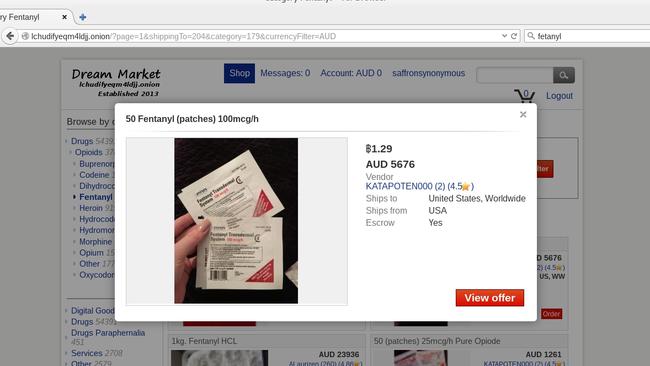The drop dead drug that creates ‘zombies’ tightens its grip
A DEADLY opioid 50 times more powerful than heroin is taking lives on Australian streets, and being rationed in hospitals.
IT’S a drug so potent that it’s being considered for use in death row executions, and it’s strengthening its grip on Australia.
A string of recent drug deaths in Melbourne and Sydney are believed to be connected to the dangerous “zombie” drug Fentanyl.
Fentanyl, in it’s illicit form, is being blamed for the worst opioid crisis in America’s history.
In Australia, the horrible irony is, as users die of overdoses of illicit fentanyl in our streets, hospitals have this year been forced to ration due to shortages of the drug in its clinical form.
Fentanyl, 50 times more potent than heroin, and much cheaper to make, already has the US in its death grip.
Also known as the “drop dead” drug, it’s now creeping steadily into Australia’s streets — courtesy of a black market in prescription versions, and, perhaps even more deadly — the fact it's being added to heroin by illicit drug makers and dealers.
Many users think they’re buying heroin.

Until a hit prompts an overdose which leaves them unconscious. Or at worst, dead.
Fentanyl was blamed for 13 deaths in Sydney in early 2015, and ten deaths by overdose in Melbourne in late 2015 were linked to the drug.
At first they were put down to a “bad batch” of heroin. Now it’s been discovered the “bad batch” contained the much more powerful opiod fentanyl.
The abuse problem isn’t confined to the cities — rural and regional areas are also in the grip of opioid addiction.
Last week, an under-resourced Townsville Hospital complained it was turning away addicts of all types — including those addicted to opioids, who were doctor-shopping to get their fix.
Deaths from fentanyl in Australia increased 1800 per cent in 15 years, ABC’s Background Briefingreported in November.
A report from the National Coronial Information Service (NCIS), revealed 498 fentanyl-related deaths occurred between January 2010 and December 2015. That was up from just 27 in the previous decade.
Senior doctors say the trend in Australia points to a similar emergency.
Few know better the power of fentanyl than Australian and New Zealand College of Anaesthetists (ANZCA) president, Professor David A Scott.
As director of anaesthesia and acute pain medicine at St Vincent’s Hospital in Melbourne he has seen and administered the drug in the clinical setting for which it’s intended.
Everything that makes it a brilliant choice as an anaesthetic or painkiller makes fentanyl deadly on the streets, he says.

“(Fentanyl) has commonly been used in anaesthesia and for more than 30 years. But the dose we administer is tiny, compared to when it is used as an illicit drug,” he said.
“Anaesthetists like it because it comes on quickly and wears off after a relatively short period of time.
Fentanyl has also been used for the treatment of chronic and severe cancer pain, with a patch form listed on the Pharmaceutical Benefits Scheme for other types of chronic pain since 2006.
There are claims some GPs, emergency doctors and specialists are overprescribing the opioid, and that they are turning up on the black market.
“The patches can be quite high levels of the drug, but the intention when they are used in palliative care is to dispense a low, slow dose so it provides a constant background level of fentanyl.
“Certainly, the opioids that are out there now are causing more harm than any good. In some cases they’re causing death — and that’s completely unacceptable,” Prof Scott said.
“People take it for the same reason they take other opioids like heroin: it is a potent narcotic and so you have a euphoric high from using a large dose.”
He says those in the greatest danger are illicit drug takers taking fentanyl either unknowingly — when it is mixed with the less potent heroin — or in ignorance of how much more powerful it is.
“The high would not be dissimilar to heroin or morphine — they get a euphoric feeling,” he said.
“You must remember some people aren’t actively choosing to take it — they are buying heroin for the heroin euphoric feeling, and then are overdosing because someone at some point has cut in fentanyl as well.
“And if you get a big dose, especially one mixed illicitly where there’s no quality control — it’s even more deadly.”
“It slows breathing. They fall unconscious. And then it stops the breathing.”
Ironically, Australian hospitals have this year suffered shortages of clinically-supplied fentanyl, after the main pharmaceutical supplier, Aspen, could not meet demand.
“Shortages which meant it was rationed peaked midyear. That problem was because Aspen got a number of new contracts across the eastern seaboard and suddenly couldn’t fulfil their requirements,” Prof Scott said.
He says it’s a bitter irony that the drug seems at times harder to get it in a legal and safe manner than it is on the street.
“It just goes to show that path ways for illicit drugs are sometimes more established,” he said.
“We should be very afraid of fentanyl in its illicit form. Used illegally, it’s very potent.
“The gap between getting the high they are after and having their breathing stop is just too, too narrow. The risk of death is just too high.”





